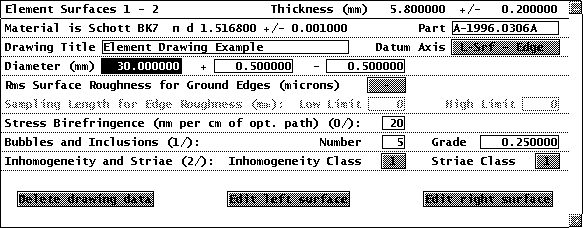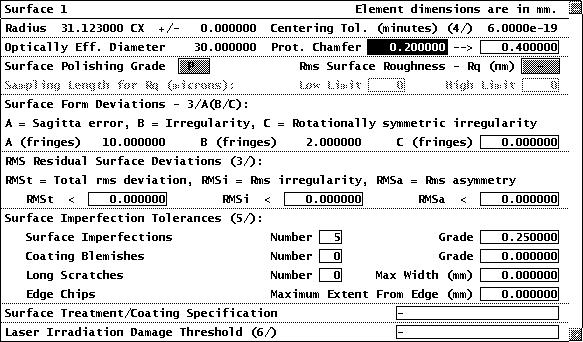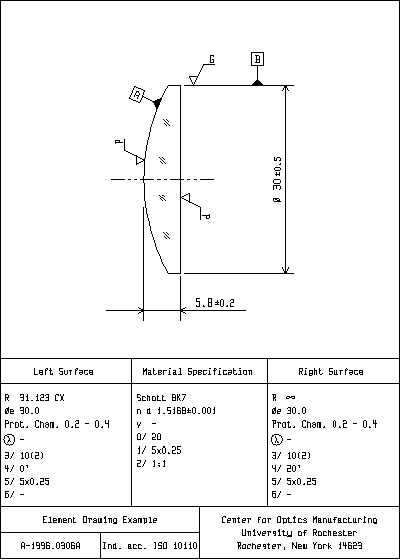SINGELEM.LEN - AN ISO 10110 ELEMENT DRAWING EXAMPLE
Singelem illustrates the use of the ISO 10110 drawing routines in OSLO to make element drawings suitable for fabrication. ISO 10110 is an international standard titled "Preparation of drawings for optical elements and systems". It prescribes not only how optical drawings should appear, but also how constructional data and tolerances should be specified. OSLO uses ISO 10110 recommendations for aspheric surface forms, default tolerances, and element drawings. Currently, the element drawing routines are limited to rotationally symmetric lenses with spherical surfaces, specified according to Part 10 of the standard, "Table representing data of a lens element". Element drawings are prepared using the Show >> Element Drawing command. This command will bring up a dialog box as shown below.

This dialog box contains the items that need to be specified for the lens as a whole. Most of the fields are set to default values obtained from the lens data, ISO 10110, or the tolerance data spreadsheet. In addition to these sources of data, the address preferences ( ad1-3) are used to fill in the title block on element drawings. Each field contains an English description of the data to be provided, and where appropriate, a numerical code (e.g. 1/ ) according to the standard. Some fields have lists that include values recommended in the standard, and these are indicated by buttons. At the bottom of the dialog box are three buttons. The first deletes all element data from a surface (such data is normally stored with the lens). The second and third buttons bring up a dialog box for editing the left and right surfaces of the lens, as shown below.

This dialog box is similar to the first, in that default values are obtained from the lens data where possible (if these data are to be changed, they must be changed in the appropriate source, e.g. tolerance data must be changed in the tolerance spreadsheet). The table on the following page gives a brief summary of the data meanings. For additional information, please consult the standard or the OSA ISO 10110 User's Guide.
- In the U.S., copies of standards are available fromAmerican National Standards Institute 11 West 42nd Street New York, NY 10036 tel (212) 642-4900 fax (212) 302-1286Copies of the ISO 10110 draft standard can be obtained fromNational Association of Photographic Manufacturers 550 Mamaroneck Avenue Harrison, NY 10528 tel (914) 698-7603 fax (914) 698-7609The "OSA User's Guide for ISO 10110" is available fromOptical Society of America 2010 Massachusetts Avenue, NW Washington, DC 20036 tel (202) 223-8130 fax (202) 223-1096
| Summary of ISO 10110 drawing codes | |
| Property and code form | Data |
| Stress birefringence 0/A | A = Maximum optical path difference (nm/cm) |
| Bubbles & inclusions 1/NxA | N = Number of bubbles A = Bubble grade number |
| Inhomogeneity and striae 2/AB | A = Homogeneity class B = Striae class |
| Surface form tolerance 3/A(B/C) or 3/A(B/C) RMSx < D or 3/- RMSx < D x is either t, i, or a | A = Maximum sagitta error B = Peak-to-valley irregularity C = Non-spherical, rotationally symmetric error D = Maximum rms tolerance t = total rms deviation from nominal surface i = rms irregularity a = rms asymmetry after removal of spherical and rotationally symmetric irregularityA,B,C,D in fringes (default l = 0.5461m m) |
| Centering tolerance 4/s | s= Surface tilt angle (minutes or seconds) |
| Surface imperfection tolerance 5/N x A; CN¢ x A¢ ; LN¢¢ x A¢¢ ; EA¢¢¢ | N = Number of allowed scratches A = Defect grade number (mm) N¢ = Number of coating blemishes A¢ = Coating blemish grade number (mm) N¢¢ = Number of long scratches (> 2mm) A¢¢ = Maximum width of scratch A¢¢¢ = Maximum extent of edge chips (mm) |
| Laser damage threshold 6/Hth;l; pdg; fp; ntsx np(pulsed) or 6/E th;l; nts(cw) |
Hth= Energy density threshold (J/cm2) E th= Power density threshold (W/cm2) l= Laser wavelength pdg = Pulse duration group f p= Pulse repetition frequency n ts= Number of test sites n p= Number of pulses per site |
The following is a drawing of the single element used for this example.


